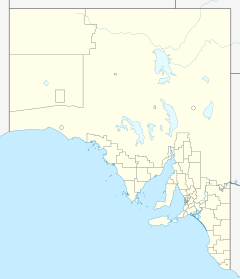Nurragi railway station facts for kids
Quick facts for kids
Site of the former Nurragi railway station
|
|
|---|---|
| Location | Australia |
| Coordinates | 35°22′17″S 138°54′33″E / 35.3713°S 138.9093°E |
| Operated by | Former South Australian Railways |
| Line(s) | Former Milang railway line |
| History | |
| Opened | 17 December 1884 |
| Closed | 17 June 1970 |
| Location | |
Imagine a time when trains chugged through the Australian countryside, connecting small towns. One such place was Nurragi, a tiny railway station in South Australia. It wasn't a busy station with lots of staff. In fact, it was an "unattended" station, meaning there were no workers there all the time.
Nurragi was part of the old Milang railway line. This line was 13.1 kilometres (about 8 miles) long. It opened way back in 1884 and closed in 1970.
Contents
Where Was Nurragi Station?
The Milang railway line started at a farming area called Sandergrove. This was where it connected to a bigger railway line. That bigger line went from Mount Barker to Victor Harbor. Today, parts of that line are used by the SteamRanger Heritage Railway.
The Milang line ended at Milang. Milang is a town right on the edge of Lake Alexandrina. Nurragi station was the only stop between Sandergrove and Milang. It was located about halfway along the line.
What Was at Nurragi Station?
Nurragi station had only a few basic things. There was a special section of track called a passing loop. This loop was 70 metres (230 yards) long. It allowed trains to pass each other or for one train to wait while another went by.
The station also had a platform where people could get on and off trains. It was a "full-height" platform, meaning it was level with the train doors. There was also a small shed. This shed was used by local farmers to store things they wanted to send by train.
The Name Nurragi
The name Nurragi comes from the local Ngarrindjeri people. They are the traditional owners of this land. In their language, "Nurragi" means "scrub country." This name perfectly described the area a long time ago. Before European settlers arrived, more than 98% of the original plants in this region were thick "scrub."
Nurragi Today: A Special Reserve
After the Milang railway line closed in 1970, the train tracks were removed. The station site was cleared away. But the story of Nurragi didn't end there!
Since 1991, the old station site has become part of the Nurragi Conservation Reserve. This reserve is now a very popular rail trail. A rail trail is a path built on an old railway line, perfect for walking or cycling.
The Nurragi Conservation Reserve is super important for nature. It protects many native plants that used to grow in the "Milang Scrub." There are over 300 different kinds of native plants here! More than 50 of these plants are very rare or special.
A group of people in the community has worked hard to bring back these native plants. Even local primary school children have helped out! They have planted many of the original Milang Scrub plants. These include Aboriginal food plants like muntries, quandongs, and native currants.
The reserve is also a vital pathway for animals and birds. It connects the lakeside area to the nearby hills. This provides them with food and safe places to live.
If you want to learn more about the station, you can visit the Milang railway museum. They have old photos and items from the station on display.
Images for kids



